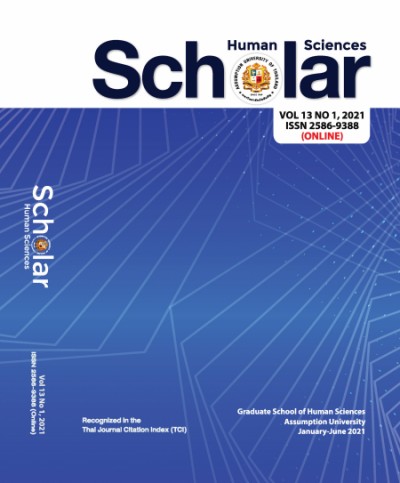The Relationship Between Teachers’ Perception Towards Administrative Support and Their Job Satisfaction in a Secondary Vocational School, Kunming, China
Keywords:
Teachers’ Perception, Administrative Support, Job SatisfactionAbstract
The main purpose of this study was to determine the relationship between teachers’ perceptions towards administrative support and their job satisfaction in a secondary vocational school, Kunming, China. 83 full-time teachers from the selected school were surveyed in this research. The researcher used Mean and Standard Deviation to analysis the teachers’ perceptions toward the level of administrative support the perceived and their job satisfaction. Pearson Product Moment Coefficient of Correlation was used to test the relationship between the two variables. The result of this study showed that teachers in the target school perceived a high level of administrative support, also, teachers’ perceptions toward job satisfaction in this school regarded as moderate. Pearson correlation tested that there was a relationship between teachers’ perceptions toward administrative support and their job satisfaction. Teachers in the target school perceived. The teachers in this school feel most satisfied with the instrumental support that provides by the principal and feel more satisfied with the intrinsic aspect of their work.
References
Backer, V. D. (2005). The Relationship between Job Satisfaction and the Perception of Administrative Support Among Early Career Secondary Choral Music Educators. ProQuest.
Beaugez, L., A. (2012). A Study of Factors Related to Teacher Attrition. The University of Southern Mississippi, The Aquila Digital Community
Blasé, J. (1987). Dimensions of Effective School Leadership: The Teacher’s Perspective. American Educational Research Journal, 24 (4), 589-610
Boyd, D., Grossman, P., Ing, M., Lankford, H., Loeb, S., & Wyckoff, J. (2011). The Influence of School Administrators on Teacher Retention Decisions. American Educational Research Journal, (2), 303-333. doi:10.3102/0002831210380788
Bozonelos, J. (2008). Retention in special education: Reducing attrition through supportive administrative interventions. International Journal of Learning. 15 (1) 149-157.
Chelladurai, P. (1999). Human resource management in sport and recreation. Champaign, IL: Human Kinetics.
Choi, N. (2017). Perceptions of Korean Special Education Teachers Regarding the Importance And Extent of Administrative Support. ProQuest, No. 10906480.
Darling-Hammond, L. (2002). Access to quality teaching: An analysis of inequality in California’s public schools. Stanford, CA: Stanford University.
Darling-Hammond, L. (2003). Keeping Good Teachers: Why It Matters, What Leaders Can Do. Educational Leadership, 60(8), 6-13.
DiPaola, M. (2012). Contemporary Challenges Confronting School Leaders. Charlotte, NC: Information Age.
Guarino, C., Santibañez, L., & Daley, G. (2006). Teacher Recruitment and Retention: A Review of the recent Empirical Literature. Review of Educational Research, 76, 173–208.
Herzberg, F., Mausner, B. & Snyderman, B. B. (1959/1993). The Motivation to Work. Transaction Publishers, New Brunswick, New Jersey.
Hicks, C. (2011). Teacher and administrator perceptions of administrative support in schools. Unpublished doctoral dissertations, Northcentral University, San Diego, CA.
House, J. S. (1981). Work stress and social support. Reading, MA: Addison- Wesley Publishing Company.
Krueger, P. J. (2000). Beginning music teachers: Will they leave the profession? Update, 19(1), 22-26
Johnson, S. & Birkeland, S. (2003), “Pursuing a ‘sense of success’: new teachers explain their career decisions”, American Educational Research Journal, Vol. 40 No. 3, pp. 581-617.
Lawler. E. (1983). Satisfaction and behavior. In R. Steers & L. Porter (Eds.). Motivation and Work Behavior. 332-345. New York: McGraw Hill
Littrell, P. C. (1992). The effects of principal support on general and special educators’ stress, job satisfaction, health, school commitment, and intent to stay in teaching. Unpublished doctoral dissertations, Virginia Polytechnic Institute and State University, Blacksburg, VA
Locke, E. A. (1976). The Nature and Causes of Job Satisfaction. In M. D. Dunnette (Ed.),
Handbook of Industrial and Organizational Psychology (pp. 1297-1349). Chicago: Rand McNally.
McElroy, E. J. (2004). Teaching for the long term. Teaching PreK-8, 35(2), 6. Moir, E. (2003). Launching the next generation of teachers through quality induction (ERIC Document No. ED479764). Retrieved from www.eric.ed.gov.
Peck, B. J. (2002). A high school principal’s challenge: Toward work environments that enhance new teacher satisfaction and retention (Doctoral dissertation, University of Wisconsin at Madison, 2002). Dissertation Abstracts International, 63(11), 3807.
Tobias, L. J. (2017). A Study of Teacher Job Satisfaction, Teacher Preferred Leadership Behaviors, and the Impact of the Leadership Behaviors on Teacher Job Satisfaction. Gardner-Webb University. ProQuest Dissertations Publishing, 2017. 10278623.
Valesky, T., & Hirth, M. (1992). Survey of the states: Special education knowledge requirements for school administrators. Exceptional Children, 58(2), 396-406.
Vroom, V. (1964). Work and Motivation. New York: John Wiley & Sons.
Xueying, W. (2015). A relationship study of teachers' perception towards professional development and their job satisfaction in Guilin University of Electronic Technology.




